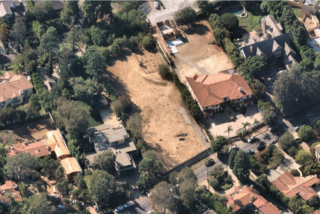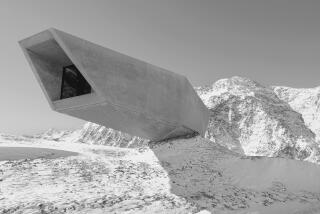Sneak Previews of Forthcoming Books : Thoughts on Architecture
‘I wanted to demonstrate that human beings, brought together in close proximity, can be accommodated in very satisfying circumstances.’
BY RICHARD NEUTRA
From “Nature Near, the late essays of Richard Neutra” with foreword by Norman Cousins and edited by William Marlin, to be published in March by Capra Press.
MY SEARCH for an architectural and environmental ethic in keeping with nature’s behavior, and including man’s own physiological and psychological makeup, eventually led me to California, as of early 1925. Settling in Los Angeles, I found a fortunate mating of climate and technology. Its subtropical environment, as yet unsullied by smog and unglutted by unkempt, tawdry sprawl, had a bracing freshness harkening back to the temperate African climate where human life originated.
There was a certain footloose optimism and informality, along with an atmosphere of expectation and experiment, in this undulant land of transplants--this “Iowa-by-the-Sea,” as some called it. And this particular transplant, being a curious Viennese, reveled in its sun-drenched, breezy contours. Doing so, I realized that I had something of a responsibility to help guide the settlement of its burgeoning population into a healthful, scenic alignment with the region’s natural characteristics and native climate.
The climate of California, at least in those halcyon days before the citrus groves and bean fields were crowded out by freeways, parking lots and subdivisions, was conducive to the budding of a fundamentally fresh form of architectural growth. I saw that buildings agleam with the materials of our own time might fraternize with the soil and psyche of this yet-unspoiled region. This was as important for cultivating our innermost well-being as sensible diet and regular exercise, and this was a connection that I felt I could get across in such a health-conscious climate.
Every building should be conceived, realizing that our most basic requirements include satisfying human feelings as well as maintaining physical health.
Neutra experimented with techniques for preventing urban sprawl, but Los Angeles spiraled outward, a development he reflects on in another essay: My most important creative challenge has been to demonstrate that density can be, more than bearable, beguiling . This was particularly exciting to me, because I initially set out on this task in the geographic center of Sprawl City, meaning Los Angeles. In 1932, I designed a house for myself and my family, calling it the VDL Research House because its construction was made possible by a loan from my early patron, Case Van der Leeuw, the Dutch industrialist and architectural aficionado.
I started designing the VDL by scrutinizing my own experience. Mine was the special case of a childhood in old-town Vienna, living in a modest middle-class tenement, followed by early manhood in military barracks and wartime hospital wards.
It became clear to me that the demonstration I had in mind lay primarily in the field of sensory phenomena, not in the merely mechanical allotment of measurable space. I recognized that man had inherited from his primal ancestry a kind of dread of the infringement on the senses that goes with crowding. Through the growth of his brain, and his ensuing inventiveness, man had been unprecedented in his manipulation of space, mastering it in all of its mechanical and measurable magnitudes. With rare exceptions, however, he had failed grossly in sizing up its sensorial and psychological aspects.
I was convinced that high-density design could succeed in a fully human way, and I saw my new house as a concrete pilot project. I wanted to demonstrate that human beings, brought together in close proximity, can be accommodated in very satisfying circumstances, taking in that precious amenity called privacy. So armed with my memories and convictions, and in direct contrast to the sense-inimical mien of my boyhood surroundings, I planted three families on my ordinary 60-by-70-foot lot, next to Silver Lake. And I was able to arrange things in such a way as to embellish our lives with abundant plantings and bracing vistas. One felt a great sense of freedom in the VDL, as everything was carefully planned to avoid interference between the various zones of the house, and there were many options for getting off by oneself.
If everyone in wildly centripetal Los Angeles had taken to heart the real and deeper significance of my demonstration project, the asphalt gestalt of this car-prone accretion might have been averted. The paved areas--the streets, freeways, and parking lots--would be a third of what they now are. People would be within walkable distance of shopping, school, work and leisure. Far fewer cars would be scrunched together on the region’s roads, emitting exhaust--and exhaustion--in this mockery of our supposed mobility. The California sky might still be as blue as when I first saw it at the beginning of 1925.
As it’s turned out, hundreds of perfect strangers have been coming by the house every year--and not just architectural enthusiasts, either. People walking by on Silver Lake Boulevard come to a halt, somehow mesmerized, and perhaps wistfully wondering why this constructive figment of clarity and composure hadn’t grown on Los Angeles generally. Still, there it is--a loquacious missionary by the curb, meant to raise the sights of urban man.
Copyright 1989 by Dione Neutra. Reprinted by permission of Capra Press, Santa Barbara .
More to Read
Sign up for our Book Club newsletter
Get the latest news, events and more from the Los Angeles Times Book Club, and help us get L.A. reading and talking.
You may occasionally receive promotional content from the Los Angeles Times.






